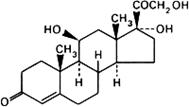Monographs: Pharmaceutical substances: Hydrocortisone (Hydrocortisonum)
Molecular formula. C21H30O5
Relative molecular mass. 362.5
Graphic formula.

Chemical name. 11β,17,21-Trihydroxypregn-4-ene-3,20-dione; CAS Reg. No. 50-23-7.
Other name. Cortisol.
Description. A white or almost white, crystalline powder; odourless.
Solubility. Very slightly soluble in water and ether R; sparingly soluble in ethanol (~750 g/l) TS and acetone R.
Category. Adrenocortical steroid.
Storage. Hydrocortisone should be kept in a well-closed container, protected from light.
Additional information. Hydrocortisone melts at about 214°C with decomposition.
Requirements
Definition. Hydrocortisone contains not less than 97.0% and not more than 102.0% of C21H30O5, calculated with reference to the dried substance.
Identity tests
• Either test A or test B may be applied.
A. Carry out the examination as described under 1.7 Spectrophotometry in the infrared region. The infrared absorption spectrum is concordant with the spectrum obtained from hydrocortisone RS or with the reference spectrum of hydrocortisone.
B. Carry out the test as described under 1.14.1 Chromatography, Thin-layer chromatography, using kieselguhr R1 as the coating substance and a mixture of 10 volumes of formamide R and 90 volumes of acetone R to impregnate the plate, dipping it about 5 mm beneath the surface of the liquid. After the solvent has reached a height of at least 16 cm, remove the plate from the chromatographic chamber and allow it to stand at room temperature until the solvent has completely evaporated. Use the impregnated plate within 2 hours, carrying out the chromatography in the same direction as the impregnation. Use chloroform R as the mobile phase. Apply separately to the plate 2 μl of each of 2 solutions in a mixture of 9 volumes of chloroform R and 1 volume of methanol R containing (A) 2.5 mg of the test substance per mL, and (B) 2.5 mg of hydrocortisone RS per mL. Develop the plate for a distance of 15 cm. After removing the plate from the chromatographic chamber, allow it to dry in air until the solvents have evaporated, heat at 120°C for 15 minutes, spray with sulfuric acid/ethanol TS, and then heat at 120°C for 10 minutes. Allow to cool, and examine the chromatogram in daylight and in ultraviolet light (365 nm). The principal spot obtained with solution A corresponds in position, appearance, and intensity with that obtained with solution B.
Specific optical rotation. Use a 10 mg/mL solution in dioxan R;  = +150° to +156°.
= +150° to +156°.
Loss on drying. Dry to constant weight at 105°C; it loses not more than 10 mg/g.
Related substances. Carry out the test as described under 1.14.1 Chromatography, Thin-layer chromatography, using silica gel R2 as the coating substance and a mixture of 77 volumes of dichloromethane R, 15 volumes of ether R, 8 volumes of methanol R and 1.2 volumes of water as the mobile phase. Apply separately to the plate 1 μl of each of 2 solutions in a mixture of 9 volumes of chloroform R and 1 volume of methanol R containing (A) 15 mg of the test substance per mL and (B) 0.30 mg of the test substance per mL. After removing the plate from the chromatographic chamber, allow it to dry in air until the solvents have evaporated, heat at 105°C for 10 minutes, allow to cool, and examine the chromatogram in ultraviolet light (254 nm). Any spot obtained with solution A, other than the principal spot, is not more intense than that obtained with solution B.
Assay. Dissolve about 20 mg, accurately weighed, in sufficient ethanol (~750 g/l) TS to produce 100 mL; dilute 5.0 mL of this solution to 100 mL with the same solvent. Measure the absorbance of a 1-cm layer of the diluted solution at the maximum at about 242 nm. Calculate the amount of C21H30O5 in the substance being tested by comparison with hydrocortisone RS, similarly and concurrently examined. In an adequately calibrated spectrophotometer the absorbance of the reference solution should be 0.44 ± 0.02 (preferably use 2-cm cells for the measurement and calculate the absorbance of a 1-cm layer).